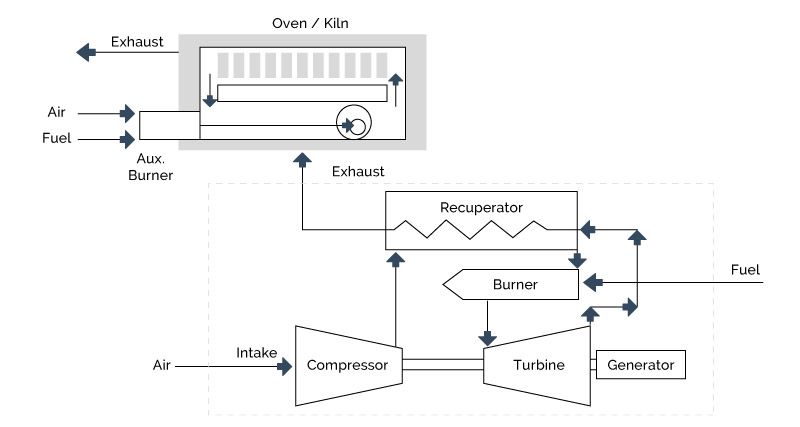5.3 Direct Heating/Drying
Direct heating and drying refers to combustion products mixing directly with the process environment (typically process solids and a forced “air” stream). Because radiation transfer is rapid, typically at high temperature, and ceases upon reaching a boundary (the outer layer of process matter), it is often undesirable and unnecessary.
Therefore, natural and forced convection heat transfer engineering may dominate dryer designs. There are a wide variety of process dryers, kilns, calciners, ovens, etc. that incorporate an even greater range of combinations in forced convection, radiation, and conduction (through the material) heat transfer principles to satisfy the product requirements. In all cases, however, the heat energy supplied to a system must perform the following four tasks:
- Heat the dryer feed to the “light” component’s vaporization temperature.
- Vaporize and/or free the liquid/byproducts above the solids’ surface.
- Heat the solids to the final desired temperature, and for the desired duration of time.
- Heat the vapor to the final desired temperature.
This is shown in schematic in Figure 5-5.

Figure 5-5
5.3.1 Process Uses
Numerous factors, including production throughput, local steam, natural gas and electricity prices, emissions restrictions, and equipment cost considerations, often result in similar solids being dried in very different ways. However, common direct drying/heating operations and their typical product/process applications include:
- Bringing variable water-weight percent feeds to a desired initial processing concentration.
- Mined raw materials and/or prepared mixes fed to cement, gypsum, ceramics, and lime processes require crushing, sizing, and drying. Rotary dryers, impact dryers, drum dryers, and others are used to handle large volume, variable composition slurries. Water removal to homogenize process streams for inorganic chemicals manufacture is also common.
- More complete drying of slurries containing finer solids within certain size/weight specifications is carried out using spray dryers, thin- film dryers, and drum dryers.
- Within the Stone, Clay, Glass and Cement manufacturing sector (SIC 32), fine dry powders are desirable for handling, packing, and/or to produce a more consistent product. Specific products include kaolin clay, fluid
cracking catalysts and ceramics that may also use this step to introduce property enriching additives/binders to the material. - Emulsion PVC and PVP polymer processes often employ spray drying to rapidly remove water without degrading product.
- Milk/dairy powders.
- Organic and inorganic dry soaps, detergents, dyes and pigments.
- Within the Stone, Clay, Glass and Cement manufacturing sector (SIC 32), fine dry powders are desirable for handling, packing, and/or to produce a more consistent product. Specific products include kaolin clay, fluid
- Pre-heating/drying materials.
- Metals fabrication and/or scrap metal industries use direct heat to remove volatile impurities (oils, plastics, paints, etc.) and/or to reduce energy demand of central furnace operations.
- Large kilns, calciners, and ovens (primarily in SIC 32) also benefit from preheated feeds, often containing preheat sections as part of the primary unit (tunnel kilns, etc.).
- Coke processes may preheat coal feeds to reduce moisture content.
- Glass and mineral wool indus tries utilize many preheat techniques to reduce energy demands or increase throughput on central furnaces systems.
- Drying and heating meant to relieve chemically bound light components and/or otherwise modify solid structure.
Rotary kilns, shaft kilns, kettle calciners, flash calciners, brick ovens/houses, tunnel kilns, regenerative kilns, and
others are included in this grouping.- Kilns and ovens used for bricks, ceramics, etc. where residence times in hot and dry conditions may last hours to days to obtain desired final qualities in appearance and structure.
- Kilns and calciners used to produce/process gypsum, plasters, cements, limestone, etc. where energy not only thoroughly removes any remaining water, but also frees intimate impurities, and forces various reactions often resulting in the release of carbon and sulfur oxides. Along with those operations in SIC 32, both the pulp & paper and beet sugar industries use these lime kiln technologies.
- Drying to remove water (and/or other solvents/chemicals) added, left, or produced during processing.
- Starch, stalk and husk dryers, and fruit peel and feed dryers, used in beet and cane sugar manufacturing, grain mill products, and other SIC 20 manufacturing sectors.
- Convection dryers in textile manufacturing.
- Veneer and other lumber/wood-furniture dryers.
- Pulp dryers, coated and tissue paper dryers in SIC 26.
- Dryers including conveyor and tray dryers used in non & cellulosic fibers (rayon, acrylics, etc.) processing, polymer rubbers manufacture, for pharmaceuticals, and latex.
